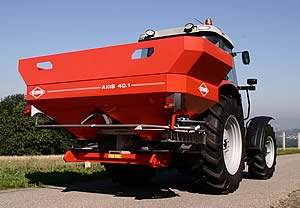 |
|||||||||
|
|||||||||||||||||||
Loris
precision fertiliser application maps now available UK farmers can now benefit from Kemira GrowHow’s Loris precision software maps. The new service which allows nitrogen fertiliser to be variably applied is available direct from the company or through GrowHow partners.
The launch follows seven years of research in winter wheat that have proved the value of precision nitrogen applications. “On average across all the trials we have measured a yield benefit of 3%,” explains GrowHow Advice Consultant Robin Thompson. “Not surprisingly however we have found that the fields which benefit most from variable rate nitrogen are those with the greatest inherent variability. In these circumstances yield benefits over 10% have been consistently recorded,” he adds. For the last three seasons field-scale trials have focused on the use of remotely sensed images to assess crop biomass from which the Loris software generates variable rate treatment maps. Uniquely, the Loris system is very flexible. “Depending on farm circumstances you can choose to provide more fertiliser to the plants in the best parts of the field (the King John approach) or to give more to the poorer parts (the Robin Hood strategy),” advises Mr Thompson. Robin Hood is generally best suited to situations where the first top dressing is being applied early i.e. pre GS30. It is also likely to be the best strategy when a crop is a bit thin or when second wheats are being grown, especially on heavy soils. In situations where early variable applications are impossible for example where bad weather prevents the taking of aerial images then King John comes into play. It is also the best tactic for first wheats and where crops are doing well, or where N-Min testing shows high residual N. Last season Loris was also tested in oilseed rape. Just as in wheat, remotely sensed images were used to assess crop biomass in the spring. But then this information was converted into a Green Area Index (GAI) map and used in Loris to produce the variable nitrogen application maps. A Robin Hood strategy was followed with extra N applied to the parts of the crop with low GAI. The result - variable applications produced a yield increase worth £20/ha. Loris is compatible with all the major tractor manufacturers so if GPS Variable Rate Technology is fitted it will simply be a matter of transferring the Loris treatment map electronically. For those without such sophisticated technology on the tractor, fields can be zoned to allow fertiliser to be applied using a conventional spreader; the rates simply being varied manually for each zone. Alternatively GPS enabled PDAs (Personal Digital Assistants) can be used to determine when to vary the rates. Loris has an initial down payment of £500 and costs £5
per hectare for each field treated. Anyone interested in finding
out more about the Loris Maps system should contact Robin Thompson
on 07701 054935.
|
|||||||||||||||||||

|
|
||||||||||||||||||
| home | agri-services | pedigree
pen | news | dairy | beef | machinery quota | property | organisations | site map |
|||||||||||||||||||

